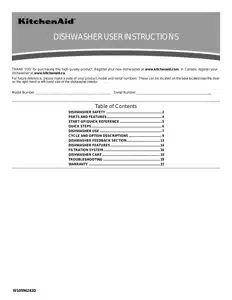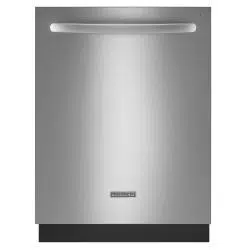Documents: Go to download!
User Manual
- Owner's manual - (English)
- Installation Instruction - (English)

- USER INSTRUCTIONS FOR KitchenAid KUDE40FXSS5
- Start-Up/Quick Reference (varies by model)
- Quick Steps
- Dishwasher Use
- Cycle and Option Descriptions
Table of contents
USER INSTRUCTIONS FOR KitchenAid KUDE40FXSS5
Table of Contents
- DISHWASHER SAFETY
- PARTS AND FEATURES
- START-UP/QUICK REFERENCE
- QUICK STEPS
- DISHWASHER USE
- CYCLE AND OPTION DESCRIPTIONS
- DISHWASHER FEEDBACK SECTION
- DISHWASHER FEATURES
- FILTRATION SYSTEM
- DISHWASHER CARE
- TROUBLESHOOTING
- WARRANTY
Start-Up/Quick Reference (varies by model)
Clean EQ Wash System removable filters to maintain peak performance.
Cleaning the filters periodically helps keep the dishwasher working at peak performance. The filters can be found at the bottom center of your dishwasher. See the “Filtration System” section for information on removing and maintaining the filters.
IMPORTANT: Do not block detergent dispenser. For hinged style detergent dispensers, tall items placed in the lower rack may block the dispenser door. Cookie sheets and cutting boards loaded on the left-hand side of the dishwasher can easily block the dispenser. If detergent is inside of the dispenser or on the bottom of the tub after the cycle is complete, the dispenser was blocked.
Drying - Rinse aid is essential.
You must use a drying agent such as a rinse aid for good drying performance (sample included). Rinse aid along with the Heat Dry or ProDry™ option will provide best drying and avoid excessive moisture in the dishwasher interior. For best drying, use the Heat Dry or ProDry™ option.
Proper Detergent Dosing
It is possible to use too much detergent in your dishwasher. This can lead to etching of your dishes. See “Add Detergent” and “Add Rinse Aid” in the “Dishwasher Use” section, to determine the amount of detergent needed based on your water hardness.
1 Hour Wash - When you need fast results.
Efficient dishwashers run longer to save water and energy, just as driving a car slower saves on gas. When you need fast results, the 1 Hour Wash will clean your dishes using slightly more water and energy. Select the Heat Dry or ProDry™ option to speed drying times (adds approximately 27 to 35 minutes to the 1 Hour Wash cycle).
ProWash™ cycle for optimal cleaning
The most advanced and versatile cycle. ProWash™ cycle senses the load size, soil amount, and toughness of soil, to adjust the cycle for optimal cleaning using only the amount of water and energy needed. The ProWash™ and Heavy Duty cycles are recommended for tough soil. No need to prerinse dishes; just scrape and load.
ProScrub® option for loading to clean baked-on food (some models)
When the ProScrub® option is selected, it provides a concentrated wash on the back of the lower dish rack for hard-to-clean dishes. Place these dishes with the soiled surface of the dish toward the ProScrub® spray jets in the lower rack of the dishwasher
Press START/RESUME every time you add a dish.
IMPORTANT: If anyone opens the door (such as, for adding a dish, even during the Delay Hours option), the Start/Resume button must be pressed each time. If the Start/Resume button is located on top of door: Push door firmly closed within 3 seconds of pressing START/RESUME. If the door is not closed within 4 seconds, the Start/ Resume button LED will flash, an audible tone will be heard, and the cycle will not start.
Quick Steps
- 1 Prepare and load dishwasher.
- 2 Add detergent for cleaning and rinse aid for drying.
- 3 Select a cycle and option.
- 4 Start dishwasher.
NOTE: If the Start/Resume button is located on the top of door, push door firmly closed within 3 seconds of pressing START/RESUME.
Dishwasher Use
STEP 1 Prepare and Load the Dishwasher
IMPORTANT: Remove leftover food, bones, toothpicks and other hard items from the dishes. Remove labels from containers before washing
■ Make sure nothing keeps spray arm(s) from spinning freely. It is important for the water spray to reach all soiled surfaces.
■ Make sure that when the dishwasher door is closed, no items are blocking the detergent dispenser.
■ Items should be loaded with soiled surfaces facing down and inward to the spray as shown. This will improve cleaning and drying results.
■ Avoid overlapping items like bowls or plates that may trap food.
■ Place plastics, small plates, and glasses in the upper rack. Wash only plastic items marked “dishwasher safe.”
■ To avoid thumping/clattering noises during operation, load dishes so they do not touch one another. Make sure lightweight load items are secured in the racks.
■ Improper loading can cause dishes to be chipped or damaged. When loading glasses or mugs, it is best to load these items in between rows of tines instead of loading them over tines as shown.
■ When loading silverware, always place sharp items pointing down. Mix items in each section of the basket with some pointing up and some down to avoid nesting. Spray cannot reach nested items.
STEP 2 Add Detergent
NOTE: If you do not plan to run a wash cycle soon, run a rinse cycle. Do not use detergent.
■ Use automatic dishwasher detergent only. Add powder, liquid, or tablet detergent just before starting a cycle.
■ Fresh automatic dishwasher detergent results in better cleaning. Store tightly closed detergent container in a cool, dry place.
Premeasured Detergents
Many detergents now come in several forms (gel packs, tablets, or powder packs). We recommend that you use high quality tablets or packs for convenience and improved performance. High quality tablets and packs have been proven better than powder, liquid, or gel detergents at reducing filming on dishes. Using tablets and packs over time will start to reduce or eliminate white film. Also, by using a rinse aid, you can minimize repeat buildup of white film. These forms are suitable for all hardness and soil levels. Always place detergents in the main compartment and slide lid to close.
Powders and Gels
■ The amount of detergent to use depends on: How much soil remains on the items – Heavily soiled loads require more detergent. The hardness of the water – If you use too little in hard water, dishes won't be clean. If you use too much in soft water, glassware can etch. Soft to Medium Water (0-6 grains per U.S. gallon) [typical water softener water and some city water] Medium to Hard Water (7-12 grains per U.S. gallon) [well water and some city water]
■ Depending on your water hardness, fill the Main Wash section of the dispenser as shown. Fill the Pre-Wash section to the level shown if needed.
NOTE: Fill amounts shown are for standard powdered detergent. Follow instructions on the package when using gel dishwasher detergents. Premeasured forms are suitable for all hardness and soil levels. Always place premeasured detergents in the main compartment and close the lid.
Add Rinse Aid (dispenser varies by model)
■ Your dishwasher is designed to use rinse aid for good drying performance. Without rinse aid, your dishes and dishwasher interior will have excessive moisture. The Heat Dry or ProDry™ option will not perform as well without rinse aid.
■ Rinse aid keeps water from forming droplets that can dry as spots or streaks. It also improves drying by allowing water to drain off of the dishes after the final rinse.
■ Rinse aid helps to reduce excess moisture on the dish racks and interior of your dishwasher.
■ Check the rinse aid indicator with the door down (varies by model). Add rinse aid when indicator drops to “Add” level.
■ Add rinse aid to hinged lid style dispenser by twisting the dispenser cap ¼ turn clockwise to open and lift off. Pour rinse aid into the opening until the indicator level is at “Full.” Replace the dispenser cap and turn to “Lock.” Make sure cap is fully locked.
■ To add rinse aid to sliding lid style dispenser, open the rinse dispenser lid by gently pushing in the center of the lid with your thumb and pulling up on the edge. Pour rinse aid into the opening until the dispenser is full. Then, close the dispenser by pushing down gently on the lid.
NOTE: For most water conditions, the factory setting will give good results. If you have hard water or notice rings or spots, try a higher setting. Turn the arrow adjuster inside the dispenser by either using your fingers or inserting a flat-blade screwdriver into the center of the arrow and turning.
Higher numbers dispense more rinse aid. You should change this setting only a little at a time and then run a few cycles before changing it again because just enough rinse aid is more effective than too much.
STEP 3
Select a Cycle (cycles vary by model)
See “Cycle and Option Descriptions” charts in the following section. Efficient dishwashers run longer to save water and energy, just as driving a car slower saves on gas. Typical cycle time is approximately 2¹⁄₂ hours, but can take less or more time to complete depending on selections.
Select Options (options vary by model)
See “Cycle and Option Descriptions” charts in the following section. You can customize your cycles by pressing the options desired. If you change your mind, press the option again to turn off the option. Not all options are available for every cycle. If an invalid option is selected for a given cycle, the lights will flash.
STEP 4 Start or Resume a Cycle
■ Run hot water at the sink nearest your dishwasher until the water is hot. Turn off water.
■ Press START/RESUME once to show which selections you used. Select the wash cycle and options desired OR press START/RESUME to repeat the same cycle and options as in the previous wash cycle.
IMPORTANT: If anyone opens the door (such as, for adding a dish, even during the Delay Hours option), the Start/Resume button must be pressed each time.
■ If the Start/Resume button is located on top of door, push door firmly closed within 4 seconds of pressing START/RESUME. If the door is not closed within 4 seconds, the Start/Resume button LED will flash, an audible tone will be heard, and the cycle will not start.
Cycle and Option Descriptions
Canceling a Cycle
1. Open the door slightly to stop the cycle. Wait for the spraying action to stop before completely opening the door.
2. Press and hold Cancel/Drain button once. The Cancel/Drain light will light up.
3. Close the door and the dishwasher starts a drain cycle (if water remains in bottom of dishwasher). Let the dishwasher drain completely. The Cancel/Drain light turns off after 2 minutes.
Changing a Cycle After Dishwasher Is Started
You can interrupt a cycle and restart your dishwasher from the beginning using the following procedure:
1. Open the door slightly to stop the cycle. Wait for the spraying action to stop, then open the door completely.
2. Check that detergent dispenser cover is still closed. If cover is open, you will need to refill the detergent dispenser before restarting your new cycle.
3. Press and hold CANCEL/DRAIN twice to reset the control.
4. Select new cycles and options.
5. Press START/RESUME.
Adding a Dish After Dishwasher Is Started
1. Check if Add a Dish indicator is lit. (Available on some models. Otherwise, proceed to Step 2.)
2. Open the door slightly to stop the cycle. Wait for the spraying action to stop, and then open the door completely.
3. Check whether the detergent dispenser cover is still closed. If it is open, the wash cycle has already started and adding a dish is not recommended.
4. If detergent has not yet been used (detergent dispenser cover is closed), you may add a dish.
5. Press START/RESUME.
See other models: 4KFP720BU1 KDRS505XSS00 KFXS25RYMS2 KECC568RPB01 KUCS03FTWH3
